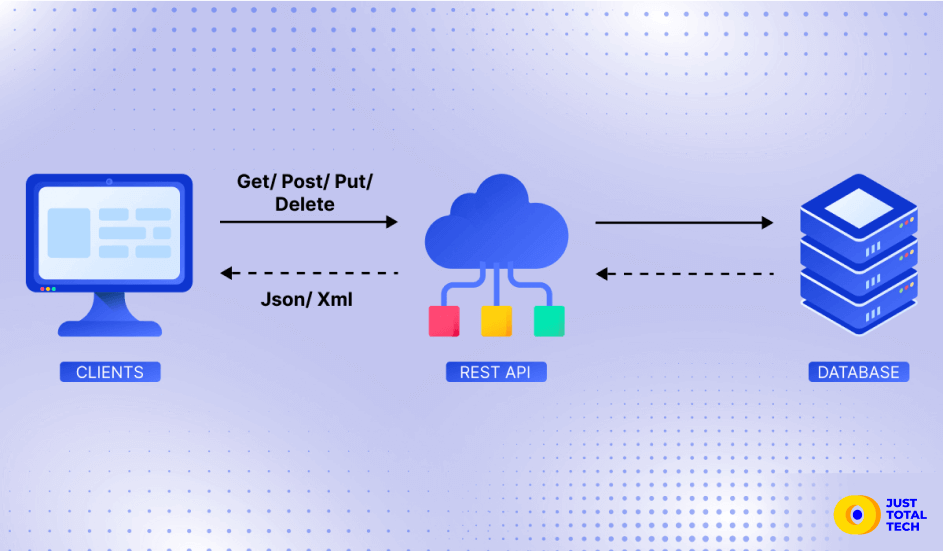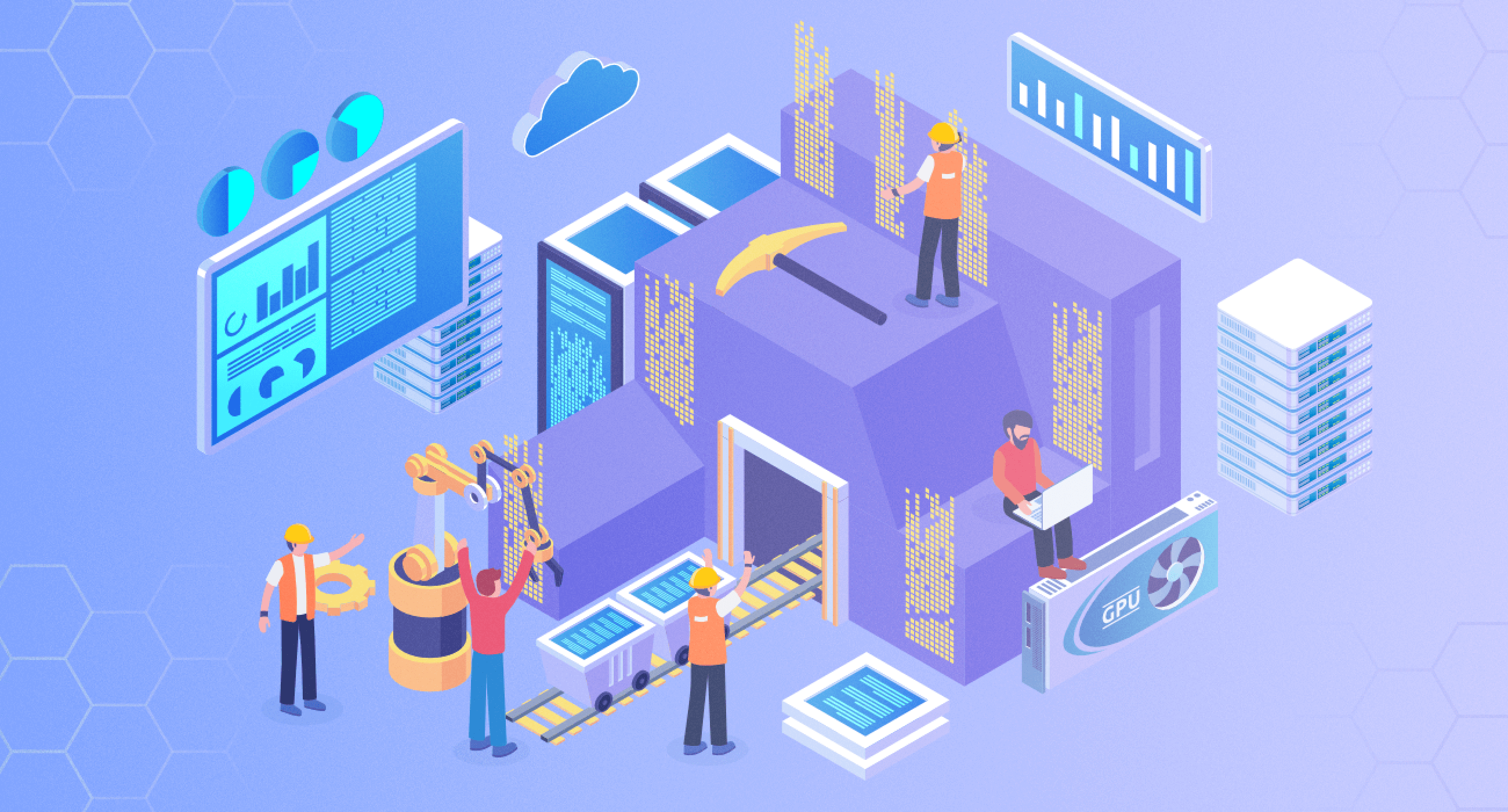Overview
REST API stands for Representational State Transfer Application Programming Interface, also known as RESTful API. REST APIs are commonly used in web applications and mobile apps, allowing developers to create their own custom interfaces to access data stored in databases.
For example, when a developer requests Facebook to get a user’s post information through APIs, the API will fetch the text and media of that post from the Facebook database. This information will come in JSON and XML formats.
What is REST API?
Let’s break the term down and understand it one by one. An API can be defined as a set of protocols and definitions that are used for building and creating application software. An API will help you communicate with the system so that it is easily fulfilled once you put in a request. It establishes a contract between the information provider and the information user, all keeping safety, security, control, and authentication in mind!

REST: It stands for “Representational State Transfer.” Eminent computer scientist Roy Fielding created it. REST is a software architectural style that is adapted to implement web services. These websites are then known as RESTful web services.
When a client requests RESTful API, the representation of the state of resources of the user is transferred to the endpoint. This information can be in the following format: HTML, XLT, Python, or simply plain text as well.
The key elements of the REST API paradigm are
- a client or software that runs on a user’s computer or smartphone and the one to initiate communication
- a server that offers an API as a medium of access to its data or features
- a resource, which is any piece of content that the server can provide to the client (it can be a video or a text file).
Working on RESTful API:
A particular request is first sent from the client to the server in the form of a web URL like HTTP GET, POST, PUT, or DELETE. When the response comes back from the server, it is in the form of a resource that can be anything like HTML, XML, Image, or JSON.
Some data formats that are compatible with RESTful APIs are:
- application/JSON
- application/XML
- application/x-web+xml
- application/x-www-form-urlencoded
- multipart/form-data
There are five methods in HTTP which are commonly used in a REST-based Architecture:
- POST request - to create data
- GET request - to fetch data
- PUT request - to create or update an existing resource
- PATCH request - to update data without modifying the complete data
- DELETE request - to delete data
Principles of REST API
1. Uniformity in Interface
REST has the following four interface constraints:
- Resource identification - Unique identification of each resource involved in the interaction between the client and the server by the interface
- Resource Manipulation using representations - The resources must have uniform representations in the server response. The resource representations are the data, the metadata describing the data, and the hypermedia links that can help the clients transition to the next desired state.
- Self-descriptive messages - Each resource representation must describe how messages are processed and how the client can perform additional actions on the server.
- Hypermedia as the engine of application state - A client should have only the initial URI of the application. The client application should drive all other resources and interactions with the help of hyperlinks.
These constraints help to provide uniformity across the application.
2. Code on demand
Under this principle, REST API permits the client's code or applets to be downloaded and used in the application. That means it doesn’t rely on its code structure and creates a smart application. This principle is optional.
3. Cacheable nature
The applications are often created cacheable by labeling the response from the server either implicitly or explicitly. If the response is cacheable, then the client can use response data for equivalent responses in the future.
4. Layered Architecture
A layered system architecture creates a systematic process or code of conduct that has to be followed. It helps balance the load, enhancing the application's overall security as components in each layer cannot interact beyond the next immediate layer they are in.
5. Statelessness
Each request is self-contained and sufficient. When one request is completed, and the next is made, the communication between the client and server does not keep track of the state of the sessions. Since the state of a session is supplied in each request, neither the client nor the server requires knowledge of the other's state to communicate. Maintaining a constant connection between the client and the server is not required, implying a higher failure tolerance. REST APIs can react to queries from multiple clients without overloading the server's ports.
6. Client-Server
As long as the API and the client code continue to communicate in the same format, they are easily changeable without affecting the other.
Advantages of RESTful API:
1. Independence: Autonomous development across several project sections is effortless since there is a separation between the client and the server.
2. Scalability: An existing website is easy to scale up because of stateless communication and a replicated repository, unlike SOAP.
3. Usage of HTTP: HTTP is the most popular implementation of REST. It connects you to any language, making the platform easier to use.
4. Management Advantage: Changes can be carried out in databases at any time, and migration from one server to another can be achieved easily. It is a huge management advantage as the front and end can be operated and hosted on different servers without hassle.
Disadvantages of RESTful API:
1. Nature of multiple APIs and Round Trips: This architectural style sometimes makes it hard to choose when the clients have to make multiple round trips to fetch their data. For the onboarding customers, it is troublesome because it increases the effort for the API owner to document the whole thing
2. Complex Environment: REST cannot be relied on for handling huge amounts of data, and its lightweight architecture makes it hard to handle complex environments as well.
3. Unpredictability: As RESTful API has no client request language, the client is left uncertain about what data the server would return.
REST APIs are impactful and highly used over others because of their simplicity in development with limited resources and fewer security requirements, browser compatibility, and scalability, all of which are what one needs for web services.
In today’s time, many eminent cloud companies use REST APIs for their applications, including Facebook, YouTube, Twitter, and Google.
Importance of APIs
There are many other industries besides software development companies that use APIs. Generally, an IT Industry uses the APIs to fulfill internal needs, such as using the APIs in mobile application development and software programs so servers can communicate with each other.
But today, many other industries that use Application Programming Interfaces (APIs) are also available. They also rely on APIs to grow faster and achieve their goals in this digital world.
E-commerce, Manufacturing, Banking, Travel, and Healthcare industries use APIs in Application development. In fact, APIs are everywhere. After implementing APIs, these industries made our lives easier. We can directly communicate or check anything through the mobile application whenever we need anything.
So, APIs have a huge impact on our day-to-day life. And with the increased adoption of APIs, the need for API testing tools has also been rising.
FAQs about REST API
1. What is the difference between REST API vs. RESTful API?
There is no major difference between REST API and RESTful API. REST API is a set of constraints, and RESTful refers to an API that follows those constraints.
2. What are the differences between PUT and PATCH
The main difference between PUT and PATCH is that PATCH only updates or modifies the given fields and doesn't change any other values. At the same time, PUT update or replace the entire resource. And create.
3. What are the four most common REST API operations?
The four HTTP methods commonly used in a REST-based Architecture are POST, GET, PUT, and DELETE.















Leave a Reply